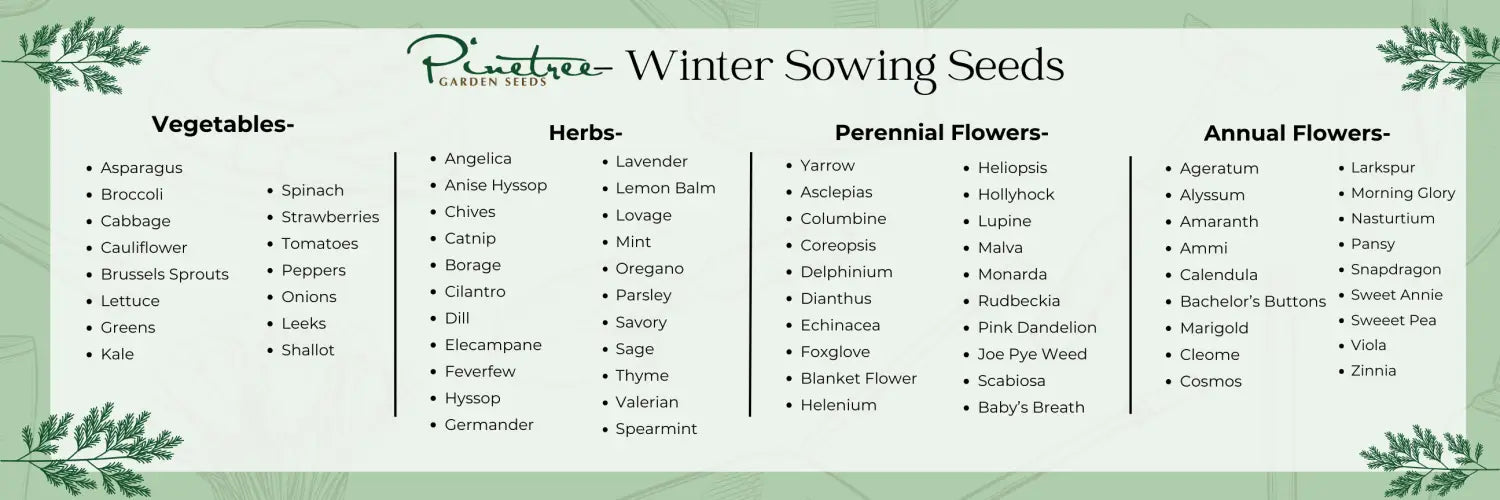Start your seeds outdoors this winter!
Stratification - The process that recreates the temperature conditions that would naturally break a seeds dormancy.
What is winter sowing?
Some seeds need a bit of cold to jumpstart their journey to the garden. This period of chilling and then warming, helps break down the seed coat leading to more successful germination and a happier plant overall. Perennials are big fans of this cold treatment and it's the reason we plant things like garlic in the fall! Though it can be recreated using a refrigerator, our preferred method is winter sowing. It's simple to do, inexpensive, saves space and doesn't require any fancy equipment. Plus, you won't have to worry about hardening off your seedlings which can be a delicate process.
It's an excellent way to beat the winter blues. Each time you walk by your milk jug greenhouses, you'll be filled with a sense of optimism about the warmer weather ahead.
Here's what you'll need:
- Plastic milk jugs, salad containers, or liter bottles. Remove stickers and labels - the tops need to be transparent!
- A box cutter or good pair of scissors
- Duct Tape (or similarly strong packing tape)
- Labels/Markers
- Soil
- Seeds (scroll down to see what types do best)
- Water - a spray bottle is helpful but not mandatory
- A good spot with plenty of natural sunlight
- and a little bit of patience
Directions:
- If using a milk jug or bottle, carefully cut your container in half leaving the top partially attached near the handle (or on one side) to create a hinge - this will help to close your lid later.
- Poke holes in the bottom of your containers using a screw or thumbtack to allow water to move through preventing soggy soil.
- Fill the bottom with 2-3" of soil and water the soil.
- Follow seed packet instructions for sowing depth.
- Water lightly - this is where a spray bottle comes in handy because the top layer doesn't need to be soaked.
- Place your labels inside so they won't be destroyed by the elements.
- Seal your container by taping the top half to the bottom half with weatherproof/waterproof tape.
- Place your mini-"greenhouses" somewhere outside where they'll get plenty of sun.
Now let nature do it's thing - time for you and your seeds to just....chill😎
Watch Matthew demonstrate how to winter sow in our latest YouTube Video:
Which seeds we winter sow and when:
Scroll down for a downloadable PDF!
January
Flowers: Aquilegia (Columbine), Coreopsis, Delphinium, Joe Pye (Eupatorium), Milkweed (Asclepias)
Herbs: Angelica, Anise Hyssop, Catnip, Elecampane, Feverfew, Hyssop, Germander, Oregano, Valerian, Spearmint
Fruits and Vegetables: Asparagus, Onions, Leeks, Sea Kale, Shallots, Strawberries
February
Flowers: Ageratum, Baby's Breath, Bishop's Flower (Ammi / False Queen Anne's Lace), Cleome, Dianthus, Echinacea, Foxglove, Blanket Flower (Gaillardia), Helenium, Heliopsis, Hollyhock, Larkspur, Lupine, Malva, Monarda (Bee Balm), Rudbeckia, Pink Dandelion, Pansy, Snapdragon, Sweet Annie, Sweet Pea, Viola
Herbs: Borage, Chives, Cilantro, Dill, Lavender, Lemon Balm, Lovage, Mint, Oregano, Parsley, Savory, Sage, Thyme
Vegetables: Onions, Leeks, Shallots
March
Flowers: Alyssum, Amaranth, Calendula, Bachelors' Buttons, Marigold, Cosmos, Morning Glory, Nasturtium, Scabiosa, Zinnia
Vegetables: Broccoli, Cabbage, Cauliflower, Brussels Sprouts, Lettuce, Leafy Greens, Kale, Spinach, Tomatoes, Peppers
The above are just suggestions from our gardeners to get you started. Be brave and experiment with a few seeds you know need a cold treatment or an early start to the season.
Answers to your FAQ's can be found HERE
And be sure to lettuce know how things grow!!
Winter Sowing List PDF Landscape
Winter Sowing List PDF Standard



I love winter sowing and one of the best things is that you don’t have to harden off the plants before you put the plants in the soil. i’ve even started tomatoes successfully using this method.
Really enjoyed your Guide to Winter Sowing video and list of seeds to try. I am going to sow some seeds this winter. Thank you !!
What is your frost date, and does it make a difference?
At this elevation (Colorado in general), we tend to have big temperature swings between night and day. Can the seedlings get too hot?
Would this work “in situ”? Could I create a little seed bed where I want the plant, and cut the bottom off the jug, and put it over a few seeds? The one problem I predict would be the wind – I might need something to weigh or stake an empty jug down.
I was planning on trying this with beans anyway. They do not need cold stratification, but something – I think birds – got most of my sprouts last year.
I’ve been winter sowing native perennials for six years in Cheyenne, Wyoming, and never tape my milk jugs closed. The plastic is flexible enough that the top can be jammed part way into the bottom. The gaps along the sides let the snow in—I don’t have to water the jugs all winter because I leave them in a shady spot until I see sprouts, usually sometime in April here. Then I move them to a sunny spot and keep an eye on moisture levels. By May I sometimes leave the tops off, but put them back on when there’s snow predicted.
We’ve been doing this for several years now and it works a treat! Makes growing from seed so danged easy. I taught my niece how to do it last year and she grew most of her garden that way. She’s a natural born cheapskate so it was right up her alley! :) I’ve got my supply of milk jugs hanging in the rafters of our barn and I’m itching to get started. Next week is the week!